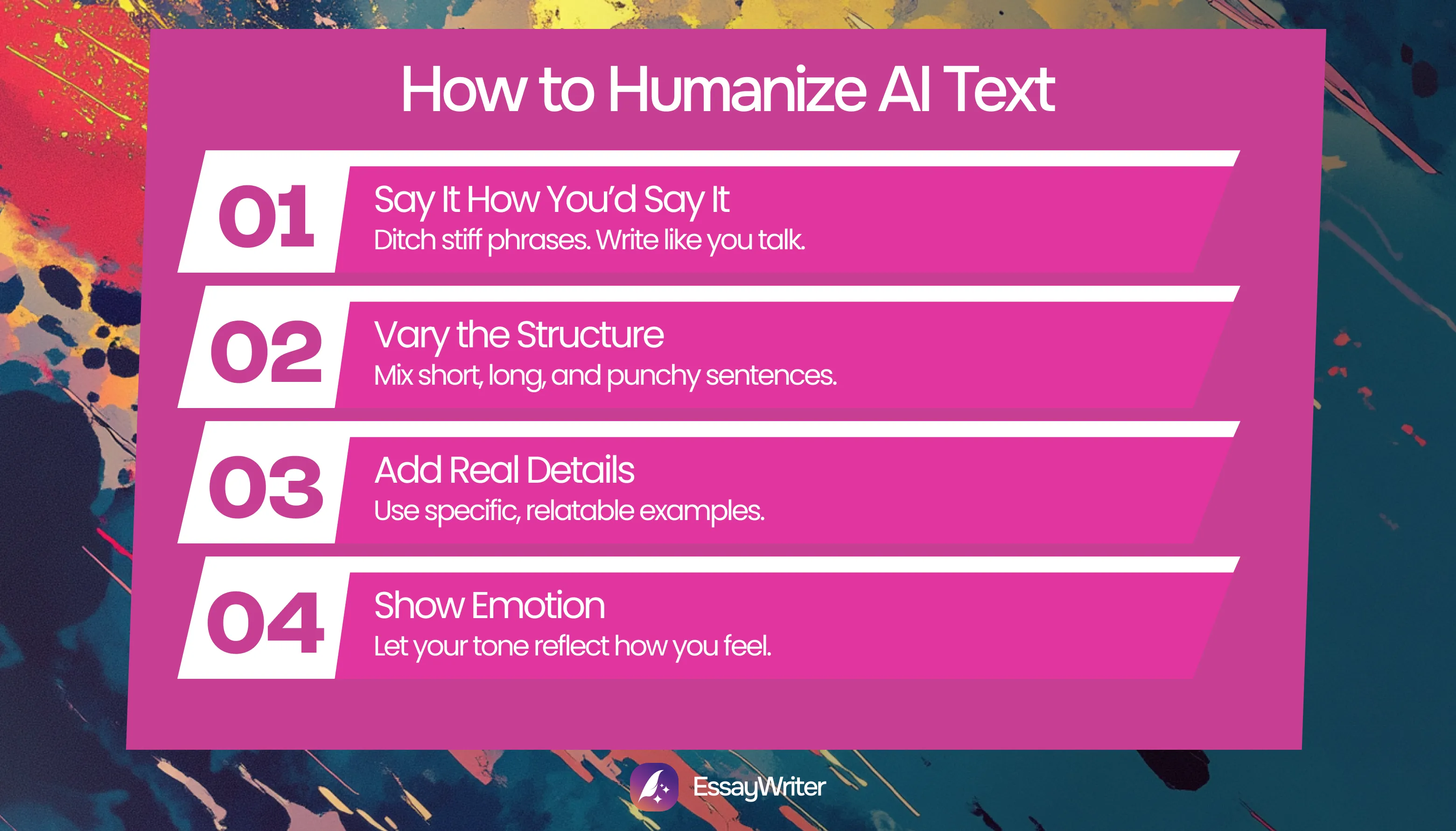You can mostly tell when a machine wrote something. That’s usually because it’s weirdly right. Too right, almost. The grammar? Spot-on. The spelling is also flawless. But somehow, it still reads like no human thought has ever touched it. There’s no personality in it.
That’s where this guide comes in with real fixes. By the end of this article, you’ll know exactly how to turn that stiff draft into something with your own voice behind it. If you’ve been using an essay generating tool and need a human hand this time, EssayWriter has got your back.
Make Your Writing Feel Human
Let EssayWriter's professionals step in and make sure your papers are 100% authentic.
Start Now
What Makes AI-Generated Content Sound Robotic
AI can write fast. That’s its thing. Give it a prompt, and boom: paragraphs. But fast doesn’t mean alive. It doesn’t mean thoughtful. AI doesn’t second-guess a word choice either, like a real person would do. So what makes its writing feel... hollow?
- Everything starts sounding the same. The rhythm’s way too tidy. You keep reading sentence after sentence without a stumble or a breath.
- The tone is too stiff. Every word sounds like a company memo, even when the topic calls for lightness.
- There’s no voice behind the words. You can’t tell who’s speaking (because no one is). It’s just words on autopilot.
- Transitions feel fake. Like it Googled “smart ways to connect ideas” and used them all at once: “Thus,” “Moreover,” “Henceforth.” People talks like that.
- Emotion never makes it in. There’s no frustration, no thrill, no eye-roll hiding between the lines. It’s all smoothed over.
- It forgets the little things. No oddly specific examples. No crumbs of real life. Just clean, forgettable sentences.
4 Tips for Humanizing AI Content
It's completely fine to use AI to write your first draft. But it should never be the final version. Below are some tips on how you can make that content sound like a real human wrote it.

Say It How You’d Say It
Start by reading your content out loud. If a sentence sounds too polished or simply not like something a person would say, that's a definite sign that it needs tweaking. Imagine you're speaking to a friend; would you say, “Moreover, one must take into account…”? Probably not.
You might say, “Also, it’s worth thinking about…” though. That small shift makes all the difference. Your goal is to sound human, not perfect, so you need to swap overly formal phrasing with language you use every day.
Vary Your Sentence Patterns
You'll notice that AI uses the same sentence structure over and over again. Those long, too-well-balanced sentences do read fine, but they don't feel natural because people write in different styles and structures. In authentic human writing, some sentences are short, others are questions, and sometimes, we pause to make a point.
So, experiment with different sentence lengths and openings; don't start every paragraph the same way.
Use Specific Details
If you want to know how to humanize AI content, the first rule is to start with emotion. AI doesn’t ramble when it’s unsure. It doesn’t sound thrilled or even mildly interested, for that matter. Your job is to bring that edge of human writing back.
Let the sentences stay a little messy so they feel like someone meant them. It’s the emotion that makes writing feel real.
Put Emotion in Words
AI avoids strong opinions and emotions. It constantly tries to keep things safe. And sure, that neutral tone might sound clean, but it definitely doesn’t sound human. One of the easiest ways to humanize AI-generated content is to not be afraid to let emotion show.
Say if you’re annoyed about something. You’re thrilled? Don’t hide it. That doesn’t translate to a full dramatic monologue every time, but the readers should feel something.
If you’re using AI for assignments, there’s probably a voice in your head asking if you’re crossing a line. Why not check? We’ve got a full breakdown of whether is it plagiarism to use AI.
AI Content vs. Human-Touched Writing: A Side-by-Side Look
You can usually tell when something was written by AI: such content follows the rules but doesn't show any feeling. That will become a lot clearer when you take a side-by-side look at AI-generated text and the same content after you've humanized it.
Original AI Version:
"It is important for students to manage their time efficiently in order to achieve academic success and personal growth."
Humanized Version:
"When school deadlines start piling up, time management becomes less of a suggestion and more of a survival skill. Learning how to handle your schedule can take some of the pressure off and help you stay focused without burning out."
You'll notice that the first one sounds polished, but distant, like it was taken out of a brochure. The second version feels more like someone who's pulled an all-nighter offering advice.
Tools That Sound Like They’ve Talked to a Human
The tools below won’t write the thing for you, and that’s a good thing. But they will help you shape what you’ve got into something that feels alive. So, if you’re still confused about how to humanize AI content, these websites are a good place to start.
Wrapping It Up (Like Humans Do)
AI can help you get started, but the real work begins when you write on your own. You can’t avoid the fact that you need human touch to make any writing relatable. Here’s what to keep in mind:
- Read everything out loud
- Break the sentence patterns
- Add details only a real person would know
- Use feeling, not filler
- Drop the robotic transitions
- Get a second opinion, preferably from someone with a pulse
Need backup? EssayWriter’s tools and real editors are ready when you are.
FAQ
Why Is Humanizing AI Content Important?
How Do I Humanize ChatGPT Content?
How to Make AI Text More Human?
- Counts, L. (2024, July 11). To err is human. And in the age of AI, it may be humanizing. - Haas News | Berkeley Haas. Haas News | Berkeley Haas. https://newsroom.haas.berkeley.edu/research/to-err-is-human-and-in-the-age-of-ai-it-may-be-humanizing/
- Guides: Artificial Intelligence Tools for Detection, Research and Writing: AI Detection. (2023). Ttu.edu. https://guides.library.ttu.edu/artificialintelligencetools/detection
Recommended articles



